HOME → ARTICLES → Principles Of Gravity Die Casting (GDC) Using Reverse Tilt
Principles Of Gravity Die Casting (GDC) Using Reverse Tilt

John Hall
President
CMH Manufacturing Company
Article Takeaways:
- Understanding the difference between reverse tiltpour and traditional tiltpour
- Advantages of reverse tilt versus low pressure die casting
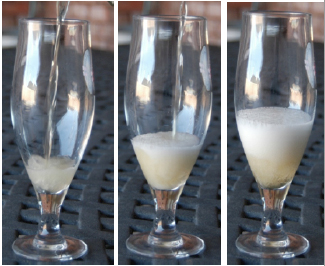 Let's have a beer - static pour
Let's have a beer - static pour
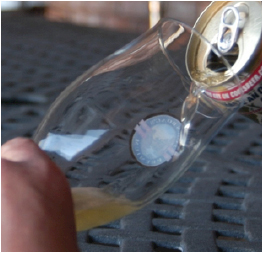
 Let's have a beer - tilt pour
Let's have a beer - tilt pour
Aluminum permanent mold casting or gravity die-casting is the casting of molten aluminum in a reusable metal mold or die. The die material is most commonly cast iron or steel.
The tilt pour process is one variation of the permanent mold process. Simply put, the tiltpour casting process is the pouring of molten aluminum into a mold by tilting the mold to fill it in a controlled fashion. In traditional tiltpouring the mold parting line is perpendicular to the floor during the solidification phase, while in reverse tilting the parting line is parallel to the floor. Turning the parting line allows the casting to be center fed similar to the way a casting produced in the low pressure process is fed. This feature makes reverse tilting a cost effective alternative to capital-intensive low-pressure casting. In many cases the casting can be direct poured, eliminating costly runner bars and increasing yield.
What is Tilt Pour GDC?
- The tiltpour casting process is the pouring of liquid aluminum into a metal mold and tilting the mold to fill it in a controlled fashion
- Filling the mold cavity by tilting, allows the liquid metal to flow down the side of the mold with little or no turbulence, filling the mold with little to no oxides
Advantages of GDC
- Better dimensional accuracy
- Less machine stock needed
- Process is machine driven
- Faster heat exchange
- Shorter cycle times
- Chilled casting has denser dendrite structure
- More pressure tightness
- Controllable heat exchange through PLC controlled chilles
- Better surface finish
- Fewer inclusions
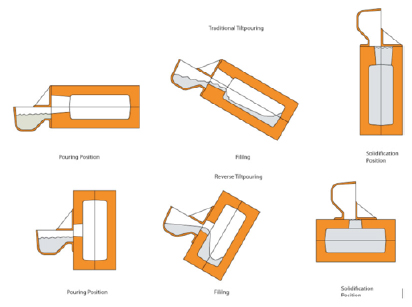 Traditional vs. Reverse Tilt
Traditional vs. Reverse Tilt
What Is Traditional Tiltpour?
- Parting line is parallel to floor for pouring cup filling
- Parting line gating
- Uses runners and ingates
- Direct pour
- Complex gating removal
- Die filling from bottom to top
- Natural venting
- Static oxide skin in runner allows clean metal to enter die
Why Reverse Tilt Pour?
- Can be used to feed castings with isolated heavy sections
- Can be used to feed castings with center symmetry
- Cookware
- Wheels
- Sheaves, sprockets, gear blanks
- Steering knuckles
- Engine components
- Impellers
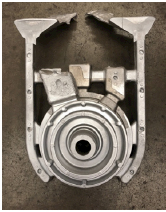 Casting Made With Traditional Tiltpour Using Parting Line Gating
Casting Made With Traditional Tiltpour Using Parting Line Gating
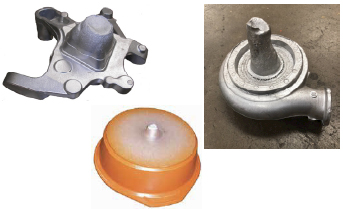 Castings Made With Reverse Tiltpour Using Riser Pour Gating
Castings Made With Reverse Tiltpour Using Riser Pour Gating
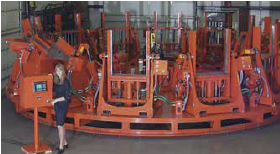 High Volume Rotary RT Table
High Volume Rotary RT Table
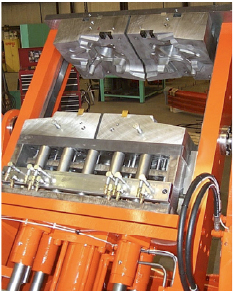 Reverse Tilt Die in Machine
Reverse Tilt Die in Machine



 Let's have a beer - tilt pour
Let's have a beer - tilt pour




